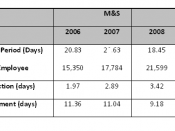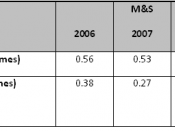UB Number: 08027841 Date of submission: 7th Dec. 2009
Programme: MBA Course Leader: Iain Ward-Campbell
Attendance mode: Distance Learning
Module Title: Business Accounting
�
Financial Analysis of Marks & Spencer Group Plc.
Executive Summary
This report aims to review and analyze the financial position of Marks and Spencer Group based on their financial statements for the last year ending March 2009. This report will be taken from the standpoint of an investor reviewing the performance of the company in 2009 and reviewing its performance over the previous three years up to 2006 in order to establish a clear view of the trends in its financial performance.
The accounting policies of Marks & Spencer Group will also be appraised against internationally accepted standards and any anomalies identified will be highlighted in the report. A peer analysis will be done with Next Plc as the peer company. Certain ratios will be compared to industry average.
The financial ratios of M & S will also be analyzed and recommendations made to remedy any issues identified.
Information for this report will be sourced mainly from the internet, FAME and the company's annual financial statements.
�
CHAPTER ONE
The Company
Marks & Spencer (M&S) started in 1884 as a small stall in Leeds where all products were sold for a penny (Burt, 2002) and is the UK's leading retailer of clothing, home-ware and food. M & S currently has over 885 stores in more than 40 territories (Wikipedia, 2009). Despite the global economic downturn, M&S recorded tremendous success and is the most preferred brand by consumers. This has been achieved by consistent focus on product quality, value for money and customer services (M&S, 2008).
According to (Mintel, 2008) M&S accounts for about 10.5% of total clothing spending by consumers and 43% of the total consumers,


